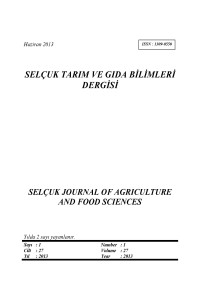Abstract
Nowadays, the fertilizer usage is seen as an essential agriculture technology. Among the vegetables produced in greenhouses, the tomato is the most important vegetable in chemical fertilizer usage per unit, during the production period. While physical total of fertilizer consumption is calculated as 287.5 kg ha-1 for Turkey, it is 344 kg ha-1 for Antalya; on drug substance (N, P2O5, K2O) basis fertilizer consumption is calculated as 113.5 kg ha-1 for Turkey and it is 137.5 kg ha-1 for Antalya. The objective of this study is to explain the environmental effects of chemical fertilizers being used in greenhouse tomato production in Antalya Province, by classifying them. For this reason, a survey has been carried out which is based on face to face interviews with 148 greenhouse farmers who were chosen by stratified random sampling and who are dealing with greenhouse tomato production in Antalya Province. With the data obtained from the producers, the total fertilizer consumption has been recorded. Afterwards, the fertilizers in itself has been classified according to its contents of N, P, P2O5, K, K2Oand the available nutrient element ratios have been calculated according to the periodic table and the fertilizer formulation. Life Cycle Analysis has been applied with the separated data and as per analysis result; it has been found that the most important effects to the environment appear in global warming, depletion of abiotic sources, eutrophication and acidification categories respectively.
Abstract
Günümüzde gübre kullanımı, gerekli bir tarım teknolojisi olarak görülmektedir. Serada üretilen sebzeler arasında domates, üretim sürecinde birim alan başına en çok kimyasal gübre kullanılan sebzelerin başında gelmektedir. Fiziki toplamda gübre tüketimi Türkiye için 28.75 kg/da iken Antalya için 34.4 kg/da; etkili bitki besin maddesi (N, P2O5, K2O) bazında gübre tüketimi Türkiye için 11.35 kg/da ve Antalya için 13.75 kg/da olarak hesaplanmıştır. Bu araştırmanın amacı, Antalya İli’nde serada domates yetiştiriciliği için kullanılan kimyasal gübrelerin çevreye olan etkilerini sınıflandırarak açıklamaktır. Bunun için Antalya İli’nde serada domates üretimi yapan ve tabakalı tesadüfî örnekleme ile seçilen 148 sera üreticisi ile yüz yüze görüşmeye dayalı anket çalışması yapılmıştır. Üreticilerden elde edilen veriler ile toplam gübre tüketimi kaydedilmiştir. Daha sonra, gübreler kendi içerisinde N, P, P2O5, K, K2O içeriklerine göre sınıflandırılmış ve etkili bitki besin maddesi oranları periyodik cetvelden ve gübre formülasyonlarından yararlanılarak hesaplanmıştır. Ayrıştırılan veriler ile Yaşamsal Döngü Analizi uygulanmış ve yapılan analiz sonucuna göre kimyasal gübrelerin; çevreye en önemli etkileri olarak sırasıyla küresel ısınma, abiyotik kaynakların tükenmesi, ötrofikasyon ve asidifikasyon kategorilerinde yer aldığı görülmüştür.
Details
| Primary Language | English |
|---|---|
| Subjects | Agricultural Policy |
| Journal Section | Research Article |
| Authors | |
| Publication Date | June 25, 2013 |
| Submission Date | January 1, 2013 |
| Published in Issue | Year 2013 Volume: 27 Issue: 1 |
Selcuk Agricultural and Food Sciences is licensed under a Creative Commons Attribution-NonCommercial 4.0 International License (CC BY NC).


